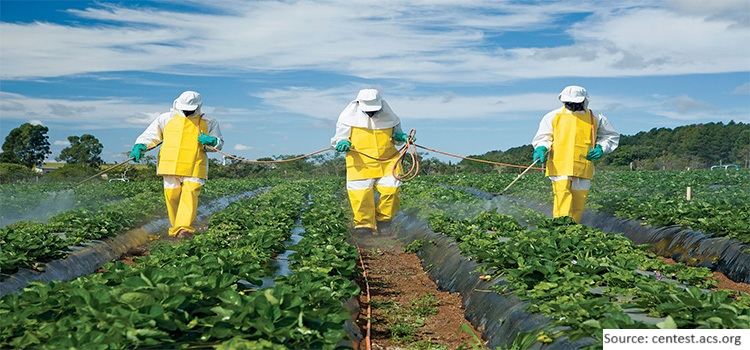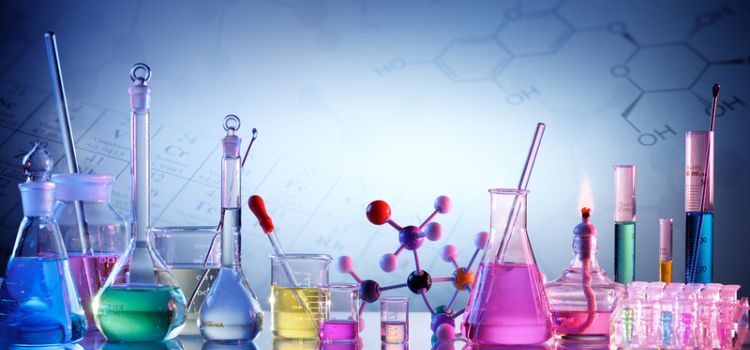
Chemical Market by Type (Basic Chemicals, Special Chemicals, Fine Chemicals, and Consumer Chemicals), by Form (Liquid, Gas, and Solid), by Components (Additives, Catalysts, Dyes and Pigments, Flavors and Fragrances, Polymers, and Solvents), and by End User (Agriculture, Automotive, Construction, Electronics, Healthcare, and Household and Personal Care)– Global Opportunity Analysis and Industry Forecast 2024–2030
Chemical Market Overview
The global Chemical Market size was valued at USD XXX billion in 2023 and is predicted to reach USD XXX billion by 2030 with a CAGR of YY% from 2024–2030.
The chemical market is a vital sector that plays a crucial role in the global economy, providing essential materials and products used across various industries, including pharmaceuticals, agriculture, energy, and manufacturing. This industry is characterized by the transformation of raw materials, such as oil, natural gas, minerals, and agricultural products, into a wide array of chemical products.
Chemical industry plays a vital role in the supply chain for providing essential raw materials, intermediates, and finished products that are necessary for the creation of numerous goods and services such as agricultural products, automotive components, construction materials, and consumer goods.
The market is highly diverse and global, with companies ranging from large multinational corporations to small-scale producers and distributors and it aims to fulfill the needs of customers while driving innovation, sustainability, and economic growth.
Market Dynamics and Trends
The expansion of the automotive industry drives the growth of the chemical industry as the demand for specialized chemicals such as coatings, adhesives, and lubricants continue to rise for manufacturing and maintenance of electric vehicles. According to the McKinsey report 2023, the automotive market for passenger cars and light commercial vehicles (LCVs) is projected to grow from 89 million units in 2019 to 102 million units in 2030, that is an increase of 12.7%. The expanding automotive market is increasing the demand for chemicals used in vehicle manufacturing and maintenance.
Moreover, the growing healthcare sector is further propelling the chemical industry's growth due to rising demand for pharmaceuticals, medical devices, and advanced materials that necessitating the need for specialized chemical products and innovative solutions.
According to the India Brank Equity Foundation (IBEF) latest report, in 2016 the Indian healthcare market was valued at USD 110 billion and it is projected to reach USD 638 billion by 2025, a projected growth of 82.7%. Also, as per the report published by the Government of Canada, the country’s medical spa market is valued at USD 9.47 billion in 2022 that accounted for 2.3% of the global market.
The burgeoning healthcare sector's need for advanced materials, active pharmaceutical ingredients (APIs), disinfectants, and diagnostic reagents compels the chemical industry to innovate and scale up production to meet these requirements.
Additionally, the growth of the cosmetic industry significantly boosts the demand for chemicals as manufacturers seek high-quality raw materials and advanced chemical formulations to meet the consumer demand for beauty and personal care products.
According to the India Brand Equity Foundation (IBEF) latest report, the global cosmetics industry is growing at CAGR of 4.3% and it is projected to reach USD 450 billion by 2025. This surge in cosmetic production necessitates the supply of specialty chemicals including emulsifiers, preservatives, colorants, and active ingredients that are essential for creating effective and appealing products that drives the chemical market expansion.
However, the increasing regulatory scrutiny and stringent environmental regulations such as Manufacture, Storage and Use of Hazardous Chemicals (MSHC) Rules, Toxic Substances Control Act (TSCA), American Chemistry Council (ACC), and European Chemicals Agency (ECHA) among others are raising compliance costs and limiting operational flexibility that hinders the chemical market growth.
On the contrary, the advancement of green chemistry innovations presents future growth opportunity for the market to revolutionize chemical manufacturing and environmental sustainability. This is accomplished by reducing waste and energy consumption while enhancing safety with non-toxic chemicals. For instance, in April 2023, Wanhua Chemical launched polyamide 12 (nylon 12) to establish a sustainable manufacturing process that utilizes environmentally friendly raw materials and innovative green chemistry techniques. This shift towards greener alternatives is expected to drive significant growth and investment in the market by fostering a more sustainable future.
Market Segmentation and Scope of The Study
The chemical market report is divided on the basis of type, form, component, end user, and region. On the basis of type, the market is divided into basic chemical, special chemical, fine chemicals and consumer chemical. Basic chemical is further divided into petrochemicals, industrial gases, inorganic chemicals, and organic chemicals. Special chemical is further classified into adhesives, sealants, coatings, cleaning materials, and additives. Consumer chemical is further bifurcated into detergents, and cosmetics, and personal care products. On the basis of form, the market is divided into liquid, gas, and solid.
On the basis of component, the market is divided into additives, catalysts, dyes and pigments, flavors and fragrances, polymers, and solvents. On the basis of end user, the market is divided into agriculture, automotive, construction, electronics, healthcare, and household and personal care. Regional breakdown and analysis of each of the aforesaid segments includes regions comprising of North America, Europe, Asia-Pacific, and RoW.
Geographical Analysis
Asia-Pacific dominates the chemical market share and is expected to continue its dominance during the forecast period. This is due to the countries in the region such as India, China, and Japan that are heavily investing in the production of chemicals to capitalize on the growing demand for industrial and consumer products.
According to the Information Technology & Innovation Foundation (ITIF) report 2024, China is the largest chemicals industry in the world and their production accounted for 44% of global chemical production in 2022. This significant production capacity drives the regional market by ensuring a steady supply of chemicals to meet increasing demand across various sectors from manufacturing to consumer goods.
Moreover, the expanding personal care industry in the region is driving investment in the production of chemicals as it necessitates the demand for skincare, haircare, and cosmetic products that fuels the market growth in the region.
According to the India Brand Equity Foundation (IBEF) report 2023, India’s overall market share is projected to reach USD 20 billion with a CAGR of 25% by 2025. This trend encourages chemical companies to invest in advanced formulations and sustainable ingredients to meet evolving consumer needs.
On the other hand, Europe is expected to show a steady rise in the chemical industry. This is due to the well-established healthcare sector in the region that drives the growth of the market by increasing demand for advanced pharmaceuticals, medical devices, and healthcare-related chemicals.
According to the latest report by Eurostat report 2024, the Germany recorded the highest healthcare expenditure among the European Union (EU) member that accounted for USD 527.79 billion in 2021 and it is equivalent to 12.9% of country’s GDP.
Moreover, France recorded USD 348.84 million followed by Italy with USD 190.27 billion, and Spain with USD 147.23 billion in 2021. The investment in healthcare sector fuels the demand for active pharmaceutical ingredients (APIs), biochemicals, and medical-gradse polymers essential for treatments such as therapies and advanced vaccines that drives the growth of the market.
Furthermore, the presence of key market players such as LyondellBasell Industries Holdings B.V., BASF SE, and others are investing in innovative product launches that propels market growth by driving advancements in chemical technologies and solutions in the region. For instance, in January 2024, LyondellBasell launched all-in-one flame-retardant compound Petrothene T3XL7420.
It provides a cross-linkable, all-in-one flame-retardant compound that reduces cost, simplifies manufacturing, and improves product quality for wire producers in automotive and appliance industry. These launches are enhancing the accessibility of chemicals that drives the market growth by broadening applications areas, improving efficiency, and catering to diverse industry needs.
Competitive Landscape
Various key players in the chemical industry includes BASF SE, Dow Inc., LyondellBasell Industries Holdings B.V., Exxon Mobil Corporation, Saudi Basic Industries Corporation (SABIC), DuPont de Nemours, Inc., Formosa Chemicals & Fibre Corp., Ineos Group Limited, LG Chem., Songwon Industrial Group, and others.
These market players are opting strategies including product launches to maintain their dominance in the market. For instance, in May 2024, SABIC announced to launch of VALOX HX325HP resin, a new injection molding with polybutylene terephthalate (PBT) resin.
It aims to offer excellent processability and chemical resistance, making it suitable for complex designs used in diabetes management devices. This innovation drives growth in the chemical industry by meeting the increasing demand for advanced materials in the healthcare sector.
Moreover, in September 2023, Dow Inc. launched lower carbon, bio-based, and circular propylene glycol solutions. This launch aims to provide sustainable alternatives for customers across various industries such as pharmaceutical, agricultural, and food.
Key Benefits
-
The report provides quantitative analysis and estimations of the chemical market from 2024 to 2030, which assists in identifying the prevailing industry opportunities.
-
The study comprises a deep-dive analysis of the current and future chemical market trends to depict prevalent investment pockets in the industry.
-
Information related to key drivers, restraints, and opportunities and their impact on the chemical market is provided in the report.
-
Competitive analysis of the key players, along with their market share is provided in the report.
-
SWOT analysis and Porters Five Forces model is elaborated on the study.
-
Value chain analysis in the chemical market study provides a clear picture of roles of stakeholders.
Chemical Market Key Segments
By Type
-
Basic Chemicals
-
Petrochemicals
-
Industrial Gases
-
Inorganic Chemicals
-
Organic Chemicals
-
-
Special Chemicals
-
Adhesives
-
Sealants
-
Coatings
-
Cleaning Materials
-
Additives
-
-
Fine Chemicals
-
Consumer Chemicals
-
Detergents
-
Cosmetics
-
Personal care Products
-
By Form
-
Liquid
-
Gas
-
Solid
By Component
-
Additives
-
Catalysts
-
Dyes and Pigments
-
Flavors and Fragrances
-
Polymers
-
Solvents
By End User
-
Agriculture
-
Automotive
-
Construction
-
Electronics
-
Healthcare
-
Household and Personal Care
By Region
-
North America
-
The U.S.
-
Canada
-
Mexico
-
-
Europe
-
The UK
-
Germany
-
France
-
Italy
-
Spain
-
Denmark
-
Netherlands
-
Finland
-
Sweden
-
Norway
-
Russia
-
Rest of Europe
-
-
Asia-Pacific
-
China
-
Japan
-
India
-
South Korea
-
Australia
-
Indonesia
-
Singapore
-
Taiwan
-
Thailand
-
Rest of Asia-Pacific
-
-
RoW
-
Latin America
-
Middle East
-
Africa
-
REPORT SCOPE AND SEGMENTATION:
|
Parameters |
Details |
|
Market Size in 2023 |
USD XXX Billion |
|
Revenue Forecast in 2030 |
USD XXX Billion |
|
Growth Rate |
CAGR of YY% from 2024 to 2030 |
|
Analysis Period |
2023–2030 |
|
Base Year Considered |
2023 |
|
Forecast Period |
2024–2030 |
|
Market Size Estimation |
Billion (USD) |
|
Growth Factors |
|
|
Countries Covered |
28 |
|
Companies Profiled |
10 |
|
Market Share |
Available for 10 companies |
|
Customization Scope |
Free customization (equivalent to up to 80 working hours of analysts) after purchase. Addition or alteration to country, regional, and segment scope. |
|
Pricing and Purchase Options |
Avail customized purchase options to meet your exact research needs. |
Key Players
-
BASF SE
-
Dow Inc.
-
LyondellBasell Industries Holdings B.V.
-
Exxon Mobil Corporation.
-
Saudi Basic Industries Corporation (SABIC)
-
DuPont de Nemours, Inc.
-
Formosa Chemicals & Fibre Corp.
-
Ineos Group Limited
-
LG Chem.
-
Songwon Industrial Group




 Speak to Our Analyst
Speak to Our Analyst































